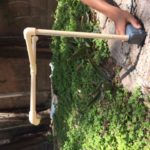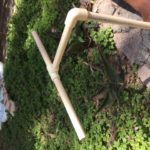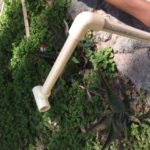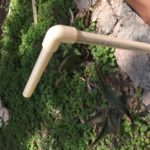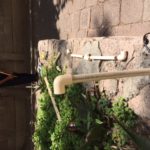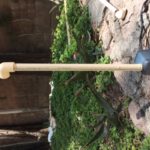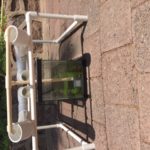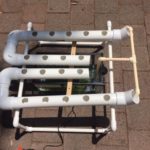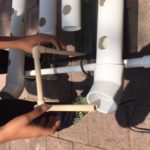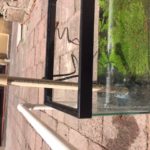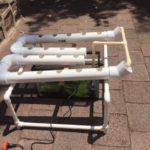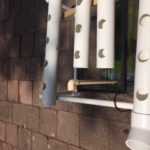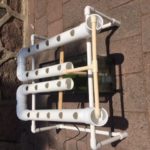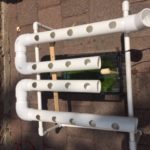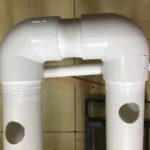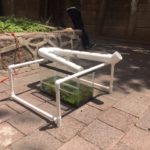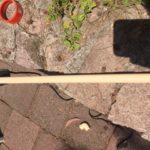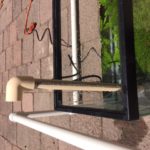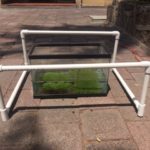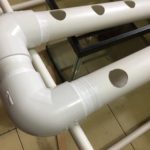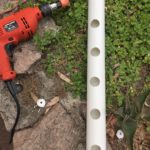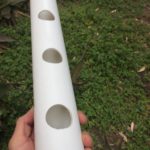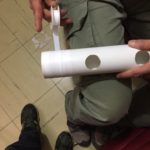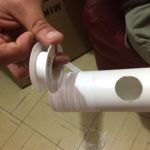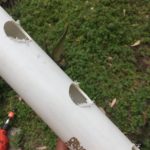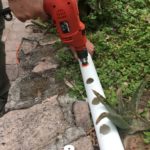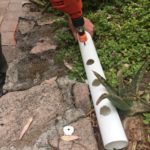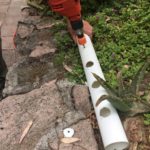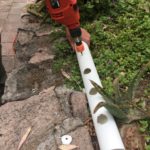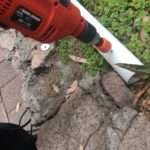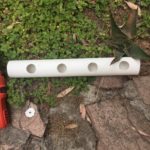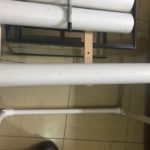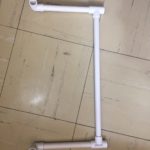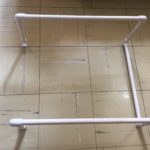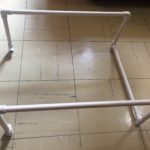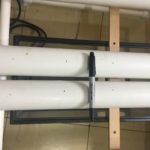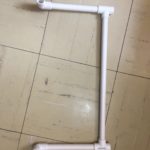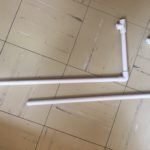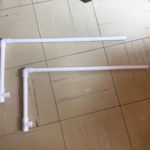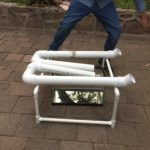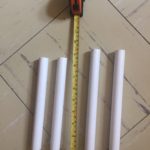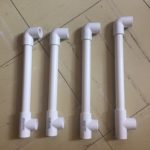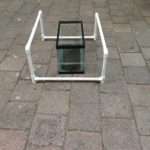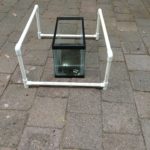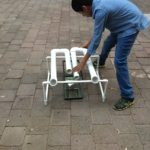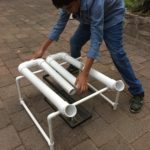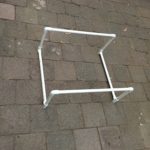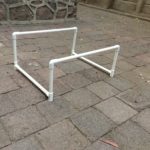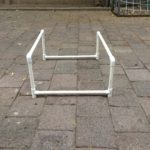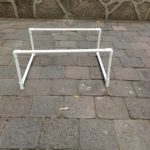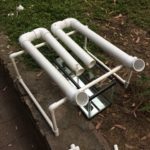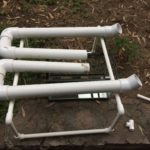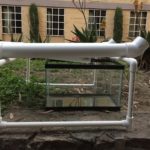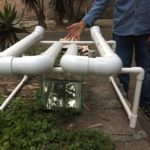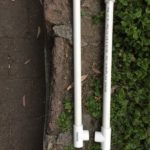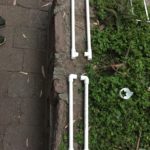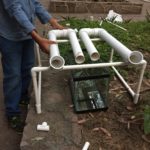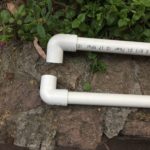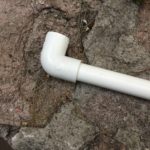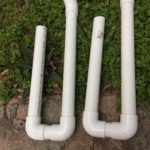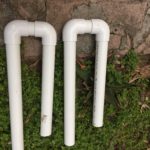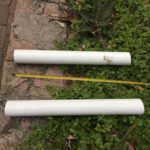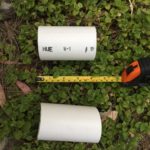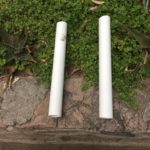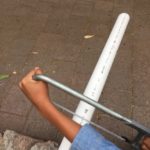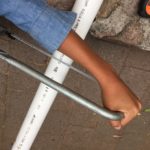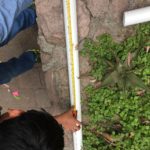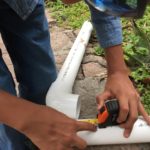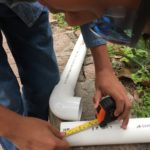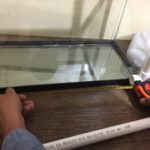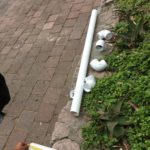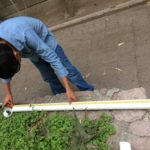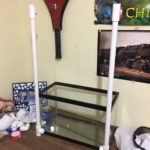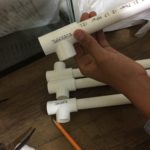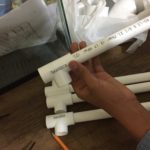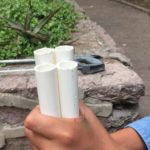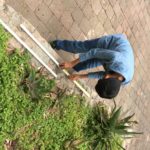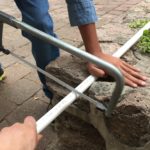El Beneficio de la Acuaponia para la Sociedad
El Beneficio de la Acuaponia para la Sociedad
Categoría: Pandilla Juvenil (1ro. 2do. y 3ro. de nivel Secundaria)
Área de participación: Ciencias Agropecuarias y de Alimentos
Resumen
Con la intención de resolver un problema de alimentación, espacio para la producción de comida, salud y desarrollo social, hemos propuesto un sistema de cultivo de manufactura casera construido con los principios y fundamentos utilizados en la acuaponia. Utilizando tubería de PVC de grado hidráulico, hemos realizado cortes y perforaciones para construir un sistema de cultivo al que se le proporcione el agua necesaria por medio de una bomba de pecera que descarga una corriente en dos puntos diferentes del circuito: en uno de ellos, se envía una corriente para nutrir 9 semillas de lechuga del tipo Ruby Sky, mientras que en otro punto se envía otra corriente para nutrir 9 semillas del tipo Starfighter. Para garantizar todo el proceso de producción, hemos germinado en casa las semillas de lechuga que usamos, bajo el principio de estar completamente involucrados en el proceso de producción de los alimentos para garantizar la calidad e higiene de los mismos. Para la germinación de las lechugas se ha utilizado una bandeja con agua en la que se ha colocado un material inerte, foami agrícola en nuestro caso, y que sirve de sustrato y soporte al momento de trasplantar las semillas germinadas y con la resistencia adecuada (plántulas) para ser instaladas en el sistema de cultivo.
El sistema de cultivo cuenta con una población de peces mixta, se tiene peces dorados, mollys y cebras, esperando sean los necesarios para nutrir 18 plantas de lechuga, que es la capacidad de producción de nuestro sistema de cultivo.
Pregunta de Investigación
¿Como elaborar un sistema de cultivo atravez de la acuaponia?Planteamiento del Problema
Existe en la humanidad una crisis de hambre, se calcula que los hambrientos ascienden actualmente 460 millones, de los cuales el 40% son niños, la gran mayoría en los países del tercer mundo. La falta de los suelos de cultivo hace que esta crisis alimentaria sea mayor. Se debe recurrir a formas de cultivo que no necesitan suelo.
La hidroponia y la acuaponia son la solución.
La escasez de alimento, los recursos hidrológicos comprometidos, la amenaza de especies que se convierten en plagas para las siembras y la poca disponibilidad de terrenos aptos para el cultivo son algunas de las razones que han llevado a la búsqueda de medios de cultivo alternativos.
La hidroponia y la acuaponia son técnicas de producción agrícola en las que se cultiva sin suelo y en donde los elementos nutritivos son integrados a una solución líquida. Han alcanzado estándares comerciales y se presenta como la alternativa para crear cultivos que brinden alimento para amortiguar el hambre en el mundo para la degradación de los suelos por el uso de químicos utilizados en los procesos agrícolas.
El concepto de utilizar heces y otros desperdicios de peces como fertilizantes para las plantas es tan viejo como las primeras civilizaciones de Asia y Sudamérica, cuyos individuos ya aplicaban métodos basados en estos principios, según los registros históricos existentes
Antecedentes
El término acuaponia se deriva de la combinación de las palabras “acuicultura” (producción de organismos acuáticos) y hidroponía (producción de plantas sin suelo). Es un sistema sustentable de producción de plantas y peces. Se compone de un tanque en el cual se producen los peces, los cuales liberan residuos ricos en nutrientes, que a través de un circuito cerrado son bombeados hacia la parte de arriba del sistema para nutrir las plantas. Las raíces, toman los nutrientes y purifican el agua que regresa por gravedad a estanque de los peces para que empiece otra vez el ciclo.
Por lo tanto, podemos decir que un sistema acuapónico es el resultado de la integración de la producción de peces (acuicultura) y de plantas sin suelo(hidroponía) dentro de un sistema cerrado, donde los desechos metabólicos de los peces (principalmente nitrógeno) son aprovechados por las plantas para crecer, y por otro lado, las plantas limpian el agua de estos componentes para mantener niveles adecuados para la cría de peces.
La acuaponía permite el ahorro de agua y recude la contaminación de la misma en más de 80%
Objetivo
Construir un sistema de cultivo orgánico atravez de la acuaponia.
Justificación
La acuaponia es un sistema de cultivo que no necesita abono ni fertilizantes, las plantas se nutren a base de las heces de los peces, el tamaño de los peces varia en la de la cantidad que se utilizan si se usan peces comestibles se nutren aun mas,se nutren a través de las raíces de las plantas, las heces se usan para llenar el agua de nutrientes con la que se riegan las plantas, o solo se puede tener el agua con los nutrientes para que sea absorbida por las raíces. Este sistema sirve para cosechar alimentos completamente orgánicos lo cual es bueno para tener buena salud y evitar enfermedades estomacales.
Hipótesis
Si logramos construir un sistema de acuaponia podremos tener cultivos mas saludables.
Método (materiales y procedimiento)
MATERIALES Y EQUIPO
1 tanque contenedor de agua o pecera.
bomba de agua sumergible.
Tubería de PVC del diámetro igual a la descarga de la bomba sumergible (5/8”). (*)
3 codos PVC de 90° para tubo de 5/8” de diámetro.
1 “T” PVC para tubo de 5/8” de diámetro.
Filtro para agua (opcional).
1 Tubo PVC de 2” de diámetro. (*)
1 Tubo PVC de ½” de diámetro. (*)
4 “T” PVC para tubo de 1/2” de diámetro. (*)
2 codos PVC de 45° para tubo 2” de diámetro. (*)
4 codos PVC de 90° para tubo ½” de diámetro. (*)
4 codos PVC de 90º para tubo 2” de diámetro. (*)
1 pedazo de madera de 30 cm de longitud.
Peces (peces dorado, mollys, guppys.
Comida para peces.
Esponja agrícola
Charola plástica
Semillas.
Taladro.
Cortacirculos de 1 ¼”.”
Arco con segueta
PROCEDIMIENTO
- Construcción de la estructura soporte.
- Cortar dos tramos de 20 cm de tubo de PVC de 1”
- Cortar dos tramos de 22.5 cm de tubo de PVC de 1”
- Colocar una T de 1” en cualquier extremo libre de cada uno de los 4 tubos anteriores.
- Colocar un codo de 90º en el extremo libre de cada uno de los 4 tubos anteriores.
- Cortar dos tramos de 60 cm de tubo de PVC de 1”
- Cortar dos tramos de 48 cm de tubo de PVC de 1”
- Unir cada tramo de 60 cm con algún tramo de 22.5 cm mediante el codo de 90º
- Unir los tramos de 20 cm mediante un tramo de 48 cm utilizando las “T” ya instaladas en el paso 3.
- Unir el extremo libre de los tramos del paso 6 con el codo libre de cada tramo de 22.5 cortados en el paso 2.
- Unir los extremos de las “T” libres mediante el tramo restante de 48 cm.
III. Construcción de los tubos de cultivo.
- Del tubo de 2” medir y cortar dos tramos de 45 cm, dos tramos de 60 cm y dos tramos de 10 cm de longitud.
- Unir cada tramo de 65 cm con un tramo de 10 cm utilizando un codo de 90º. Colocar otro codo de 90º en el extremo libre del tubo de 10 cm.
- Unir el tramo de 45 cm a la estructura del paso anterior utilizando el extremo libre del codo de 90º recién colocado.
- Colocar en cada extremo de cada tubo de 60 cm un codo de 45º
- En la estructura recién construída, marcar cada 10 cm los lugares en donde se realizarán las perforaciones para el cultivo.
- Desensamblar la estructura y realizar los barrenos en las posiciones marcadas utilizando el cortacirculos de 1 ¼”.
- Ensamblar nuevamente las piezas siguiendo los pasos 2 al 4 utilizando cinta teflón en cada extremo de los tubos de PVC.
- Construcción del sistema de irrigación.
- Cortar un tramo de 31 cm del tubo de PVC de 5/8”
- Colocar un codo de 90º en uno de los extremos del tubo recién cortado. Embonar el extremo libre en la descarga de la bomba sumergible.
- Cortar un tramo de 17 cm del tubo de PVC de 5/8”. Embonar en el extremo libre del codo colocado en el paso 2.
- En el extremo libre del tramo embonado en el paso anterior, insertar una “T” de 5/8”.
- Cortar dos tramos de 18 cm del tubo de PVC de 5/8”. Embonar cada uno de ellos en cada extreme libre de la “T” recién colocada.
- Colocar un codo de 90º en cada extremo libre de los tramos de 18 cm colocados en el paso anterior.
- Procedimiento de ensamble.
- Colocar la estructura base en el lugar en el que se montará el dispositivo. La pecera debe quedar en la parte interior, como se muestra en la imagen.
- Colocar los tubos de cultivo de forma transversal sobre la estructura, con las descargas dirigidas hacia en interior de la pecera.
- Instalar el sistema de irrigación como se muestra en las siguientes imágenes.
- El sistema está listo para utilizarse.
- Germinación de lechugas.
- Decidimos trabajar con semillas de lechuga de dos tipos: Ruby Sky, y Starfighter. Estas semillas tienen una capa protectora que facilita el proceso de germinación, se conocen como semillas peletizadas.
- Para el proceso de germinación de la lechugas utilizamos foami agrícola en presentación de placa de 30×30 cm con cortes y perforaciones para colocar las semillas.
- En una bandeja con agua colocamos la placa de foami agrícola teniendo cuidado de rellenarla cuando se requiera.
VII. Preparación de la pecera.
- Colocar en la pecera gravilla y agua limpia.
- Seleccionar los peces que se utilizarán en el sistema. En nuestro caso se trata de peces dorados y mollys. Ambientarlos en la pecera antes de colocarlos en ella.
3. Colocar los peces en la pecera y alimentarlos dos veces al día.
Resultados
En esta etapa del experimento contamos con un sistema de cultivo instalado formado por una pecera con peces dorados y mollys con agua que se encuentra recirculando por un sistema de cultivo formado de tubos de PVC de 2” de tipo hidraulico con perforaciones en las que se colocarán cubos de foami agrícola en los que hay semillas de lechuga del tipo Ruby Sky, y Starfighter. El sistema está conectado a la electricidad de forma permanente, suministrando energía a la bomba de recirculación. Al interior de los tubos de cultivo se han establecido corrientes de agua para nutrir las lechugas cuando se coloquen ahí.
Discusión
A pesar de tener un control sobre la alimentación de los peces, el agua se nota turbia, por lo que hemos pensado instalar un filtro mecánico para facilitar la limpieza del agua. Un típico filtro de pecera puede ser la solución.
Otra forma de controlar la calidad del agua de nuestro sistema, es midiendo el PH del agua del circuito y llevar un registro de los resultados.
Posiblemente sea necesario incrementar la población de peces para obtener los nutriente necesarios para la cantidad de lechugas que queremos cultivar, 18 en total.
Conclusiones
Es posible realizar en casa, en un espacio pequeño, la instalación de un sistema de cultivo acuaponico casero en el que pudimos cultivar dos variedades le lechugas: Ruby Sky y Starfighter (9 de cada tipo). Germinamos en una semana las semillas y las trasplantamos utilizando el foami agrícola en el que las germinamos, pues resultó ideal para colocarlo en los tubos de cultivo.
A lo largo del desarrollo del proyecto descubrimos que el pez dorado el que mejor se adapta a las condiciones climatológicas.
Dos lechugas se han secado (una de cada tipo germinada). La razón es que no le llegaba la cantidad adecuada de agua, por lo que de ahora en adelante vigilamos que todas las esponjas estén debidamente humedecidas.
Como consecuencia del proceso de aprendizaje, hemos tenido que reemplazar plantas dañadas o que han muerto, al hacerlos hemos aprendido nuevas técnicas para mantener el agua limpia y a la temperatura adecuada, evitando así la muerte de los peces de nuestro sistema. También implementamos unas canastillas de cultivo que mantienen a la planta más segura y nos dimos cuenta de los cuidados constantes que requiere el experimento: comida para peces, limpieza de la pecera, reposición de pérdidas de agua por evaporación, cuidado contra el exceso de sol o lluvia, etc.
Nuestro cultivo va tomando forma y cada vez son mas grandes las plantas y los peces se ven saludables. Con los cuidados adecuados esperamos reducir al mínimo las pérdidas tanto de peces como de plantas.
Bibliografía
- Técnicas de Acuaponia. Pablo Candarle. Centro Nacional de Desarrollo Acuícola (CENADAC), Dirección de acuicultura.
- Small-scale aquaponic food production. Integrated fish and plant farming. Feed and Agriculture Organization of the United Nations
- Instalación y manejo de sistemas de cultivo acuapónicos a pequeña escala. Ing. Alessandro Calagrosso.
El Beneficio de la Acuaponia para la Sociedad
El Beneficio de la Acuaponia para la Sociedad
Summary
With the intention of solving a problem of food, space for food production, health and social development, we have proposed a home-grown farming system built with the principles and fundamentals used in aquaponics. Using hydraulic grade PVC pipe, we have made cuts and perforations to construct a farming system to which the necessary water is supplied by means of a fish tank pump that discharges a current in two different points of the circuit: in one of them, a stream is sent to feed 9 seeds of lettuce of the Ruby Sky type, while in a different point another stream is sent to feed 9 seeds of the Starfighter type. In order to guarantee the entire production process, we have germinated the lettuce seeds we use at home, under the principle of being completely involved in the food production process to ensure the quality and hygiene of the same. For the germination of the lettuces, a tray with water has been used in which an inert, foamy agricultural material is placed in our case, and serves as substrate and support at the moment of transplanting the germinated seeds and with the adequate resistance (seedlings ) to be installed in the farming system.
The farming system has a mixed fish population, we have golden fish, mollies and zebras, hoping they are the necessary to feed 18 lettuce plants, which is the production capacity of our planting system.
Research Question
How to elaborate a cropping system through the aquaponic method?Problem approach
Humanity exists in a crisis of hunger, it is estimated that starving people now amount to 460 million, of which 40% are children, the vast majority in the countries of the third world. The lack of soils makes this food crisis more serious. We must resort to forms of cultivation that do not need soil.
Hydroponics and aquaponics are the solution.
Food scarcity, compromised hydrological resources, the threat of species that become pests for plantings and the scarce availability of suitable land for cultivation are some of the reasons that have led to the search for alternative means of cultivation.
Hydroponics and aquaponics are agricultural production techniques in which crops are grown without soil and where the nutrient elements are integrated into a liquid solution. They have reached commercial standards and are presented as the alternative to create crops that provide food to cushion hunger in the world for the degradation of soils by the use of chemicals used in agricultural processes.
The concept of using stools and other fish waste as fertilizer for plants is as old as the early civilizations of Asia and South America, whose individuals already applied methods based on these principles, according to existing historical records.
Background
The term aquaponics is derived from the combination of the words “aquaculture” (production of aquatic organisms) and hydroponics (production of plants without soil). It is a sustainable system for the production of plants and fish. It consists of a tank in which the fish are produced, which releases nutrient rich residues, which are pumped through a closed circuit to the top of the system to nourish the plants. The roots, take the nutrients and purify the water that returns by gravity to fish pond to start the cycle again.
Therefore, we can say that an aquaponic system is the result of the integration of the production of fish (aquaculture) and of plants without soil (hydroponics) inside a closed system, where the metabolic wastes of the fish (mainly nitrogen) are Used by plants to grow, and on the other hand, the plants clean the water of these components to maintain adequate levels for fish farming.
The aquaponía allows the saving of water and recovers the contamination of the same in more than 80%
Objective
To develop a cropping system through the aquaponic method.
Justification
Aquaponics is a farming system that does not require manure or fertilizer, plants are fed through fish stools. The size of the fish varies according to the amount of desirable crops. If it is used edible fish, the plants are further nourished. The plants are nourished through their own roots. The stools are used to fill the water with nutrients that nourish the plants, or can only have water with nutrients to be absorbed by the roots. This system is used to harvest completely organic foods which are completely healthy and help us to avoid stomach diseases.
Hypothesis
If we can develop a cropping system through the aquaponic method, we can have healthier crops.
Method (materials and procedure)
MATERIALS AND EQUIPMENT
1 containing tank water or fish tank.
1 submersible water pump.
Enough PVC pipe, in the same diameter as the discharge of the submersible pump (5/8 “). (*)
3 90 ° PVC elbows for 5/8 “diameter pipe.
1 “T” PVC for 5/8 “diameter pipe.
1 Water filter (optional).
1 PVC pipe of 2″ diameter. (*)
1 PVC pipe of 1/2″ in diameter.. (*)
4 “T” PVC connectors for 1/2″ diameter pipe. (*)
2 PVC elbows 45 ° for 2″ diameter pipe. (*)
4 PVC elbows 90 ° for tube ½” diameter. (*)
4 PVC elbows 90º for tube 2″ diameter. (*)
1 piece of wood 30 cm long.
Different types of fish (goldfish, molly fish, guppies)
Fish food.
Agricultural sponge
Plastic tray
Seeds.
Drill.
1 Tile hole cutters ¼ “.
Arch with tail
PROCESS
- Construction of the support structure.
- Cut two 20 cm length of the 1 ” PVC pipe.
- Cut two 22.5-cm sections of the 1 ” PVC pipe.
- Place a 1″T connector into any free end of each of the 4 previous tubes.
- Place a 90 ° elbow on the free end of each of the 4 previous tubes.
- Cut two 60 cm length of the 1″ PVC pipe.
- Cut two 48 cm length of the 1″ PVC pipe.
- Join each 60 cm section with a 22.5 cm section using the 90 ° elbow
- Join the 20 cm sections using a 48 cm section using the “T” already installed in step 3.
- Join the free end of the sections of step 6 with the free elbow of each section of 22.5 cut in step 2.
- Join the ends of the rest “T” connectors through the remaining 48 cm.
III. Construction of farming tubes.
- From the 2″ tube, measure and cut two 45 cm sections, two 60 cm sections and two 10 cm length.
- Join each 65 cm section with a 10 cm section using a 90 ° elbow. Put another 90 ° elbow on the free end of the 10 cm tube.
- Join the 45 cm section to the previous step structure using the free end of the recently 90 ° elbow placed.
- Place at each end of each 60 cm tube a 45 ° elbow
- In the newly constructed structure, mark every 10 cm the places where there will be the drilling made for the planting.
- Disassemble the structure and drill the holes in the marked positions using the 1 ¼ ” tile hole cutter.
- Reassemble the parts following steps 2 to 4 using Teflon tape on each end of the PVC pipes.
- Construction of the irrigation system.
- Cut a 31 cm section of the 5/8 ” PVC pipe.
- Place a 90 ° elbow on one end of the recent cut tube. Fit the free end in the submersible pump discharge.
- Cut a 17 cm length of 5/8″ PVC pipe. Fit it at the free end of the elbow placed in step 2.
- At the free end of the trunking section in the previous step, insert a 5/8″ T connector.
- Cut two 18 cm length 5/8″ PVC pipe. Fit each of them in each free end of the “T” just placed.
- Put a 90° elbow on each free end of the 18 cm length placed in the previous step.
- Assembly procedure.
- Put the base structure where the device will be mounted. The fish tank should be put within, as it is shown in the picture.
- Place the farming pipes crosswise on the structure, with the directed discharges towards the inside of the fish tank.
- Install the irrigation system as shown in the following pictures.
- The system is ready to be used.
- Germination of lettuces.
- We decided to work with lettuce seeds of two types: Ruby Sky, and Starfighter. These seeds have a protective layer that facilitates the germination process, they are known as pelleted seeds.
- For the germination process of the lettuce we use agricultural foamy in a presentation of a plate of 30×30 cm with cuts and perforations to place the seeds.
- In a tray with water we place the foamy agricultural plate taking care to fill it when required.
VII. Preparation of the fish tank.
- Put gravel and clean water in the bowl.
- Select the fish to be used in the system. In our case they are goldfish and mollies. Arrange the correct environment within the bowl before placing them into the fish tank.
3. Put the fish in the fish tank and feed them twice a day.
Results
In this stage of the experiment we have an installed planting system formed by a fish tank with goldfish and mollies with water that is being recirculated by a system consisting of tubes of PVC of 2″ of hydraulic type with perforations in which there will be placed agricultural Foamy buckets in which there are lettuce seeds of the Ruby Sky type, and Starfighter. The system is connected to the electricity permanently, supplying energy to the recirculation pump. Inside the farming tubes, water currents have been arranged to feed the lettuce when it is placed there.
Discussion
Despite having a control over the feeding of the fish, the water is cloudy, so we have thought to install a mechanical filter to facilitate the cleaning of the water. A typical fish tank filter may be the solution.
Another way to control the water quality of our system is to measure the pH of the water in the circuit and keep a record of the results.
It may be necessary to increase the fish population to obtain the necessary nutrients for the number of lettuces we want to grow, which number 18 in all.
Conclusions
It is possible to make a home aquaponic farming system in a small space in which we could cultivate two lettuce varieties: Ruby Sky and Starfighter (9 of each type). We germinated the seeds in a week and transplanted them using the agricultural foamy in which we germinated them, because it was ideal to place it in the culture tubes.
Throughout the development of the project we discovered that goldfish is best adapted to the weather conditions.
Two lettuces have dried (one of each germinated type). The reason is that the adequate amount of water did not reach to them, so from now on we will make sure that all the sponges are properly moistened.
As a result of the learning process, we have had to replace damaged or dead plants, by doing so we have learned new techniques to keep the water clean and at the right temperature, thus avoiding the death of the fish in our system. We also implemented some growing baskets that kept the plant safer and we realized the constant care that the experiment requires: fish food, cleaning the fish tank, replacing water losses by evaporation, taking care of the excess sun or rain, etcetera.
Our farming is taking shape and the plants are getting bigger and the fish look healthy. With the right care we hope to minimize the loss of both fish and plants.
Bibliography
- Técnicas de Acuaponia. Pablo Candarle. Centro Nacional de Desarrollo Acuícola (CENADAC), Dirección de acuicultura.
- Small-scale aquaponic food production. Integrated fish and plant farming. Feed and Agriculture Organization of the United Nations
- Instalación y manejo de sistemas de cultivo acuapónicos a pequeña escala. Ing. Alessandro Calagrosso.


